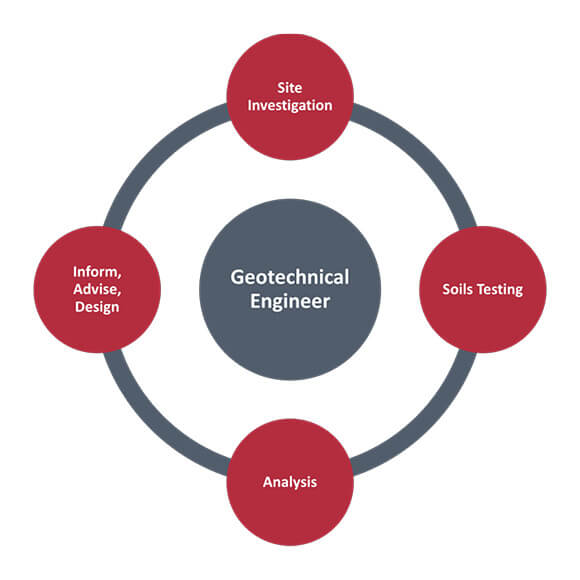More About Geotheta
More About Geotheta
Blog Article
Some Known Details About Geotheta
Table of ContentsThe Buzz on GeothetaRumored Buzz on GeothetaIndicators on Geotheta You Need To KnowGeotheta Things To Know Before You BuyThe 9-Minute Rule for Geotheta

They perform site examinations, collect samples, carry out research laboratory examinations, and analyze information to evaluate the suitability of the ground for building jobs - Engineer of Record. Based on their searchings for, geotechnical designers give recommendations for foundation style, slope stability, maintaining frameworks, and reduction of geotechnical threats. They team up with various other professionals, such as engineers, architectural engineers, and building teams, to guarantee that geotechnical considerations are integrated into the total task style and execution
By assessing the habits and homes of soil and rock, they can identify possible geotechnical threats such as landslides, soil negotiation, or slope instability. Their competence helps prevent failures or accidents that can jeopardize lives and residential property. Below are some thorough tasks and responsibilities of a geotechnical engineer: Site Examination: Geotechnical designers conduct site investigations to collect data on subsurface conditions.
They interpret the data to comprehend the buildings and habits of the soil and rock, including their toughness, leaks in the structure, compaction qualities, and groundwater problems. Geotechnical Evaluation and Design: Geotechnical designers evaluate the information collected during site investigations to analyze the stability and suitability of the site for building and construction jobs. They execute geotechnical calculations and modeling to assess elements such as birthing capacity, settlement, slope security, lateral earth stress, and groundwater flow.
Geotheta Fundamentals Explained
Foundation Layout: Geotechnical designers play an essential duty in developing foundations that can securely sustain the designated structure. They assess the dirt problems and lots requirements to establish the suitable foundation kind, such as superficial foundations (e.g., grounds), deep foundations (e.g (https://www.dreamstime.com/ianhammond2191_info)., stacks), or specialized strategies like dirt enhancement. They consider elements such as negotiation restrictions, bearing ability, and soil-structure communication to develop optimum structure styles
They assess building and construction plans, monitor website tasks, and carry out area examinations to validate that the style suggestions are complied with. If unpredicted geotechnical problems arise, they evaluate the scenario and give referrals for remediation or adjustments to the design. Risk Analysis and Reduction: Geotechnical designers assess geotechnical risks and risks related to the task site, such as landslides, liquefaction, or dirt erosion.

Collaboration and Communication: Geotechnical designers function carefully with various other experts included in a project, such as engineers, structural engineers, and building teams. Reliable communication and partnership are necessary to integrate geotechnical considerations into the overall task design and construction procedure. Geotechnical engineers supply technical competence, solution queries, and guarantee that geotechnical needs are met.
The Ultimate Guide To Geotheta
Here are some kinds of geotechnical engineers: Structure Designer: Structure designers concentrate on designing and evaluating foundations for structures. They examine the dirt problems, lots needs, and website features to determine the most suitable foundation type and design, such as superficial foundations, deep structures, or specialized methods like pile structures.
They review the factors affecting incline stability, such as soil properties, groundwater conditions, and slope geometry, and establish approaches to protect against slope failures and mitigate risks. Earthquake Engineer: Quake designers concentrate on evaluating and creating frameworks to withstand seismic pressures. They assess the seismic risk of a site, evaluate soil liquefaction potential, and create seismic design requirements to make certain the safety and security and strength of frameworks during earthquakes.
They perform area testing, collect samples, and examine the gathered data to characterize the dirt homes, geologic formations, and groundwater problems at a site. Geotechnical Instrumentation Engineer: Geotechnical instrumentation designers concentrate on surveillance and determining the habits of soil, rock, and structures. They mount and preserve instrumentation systems that monitor aspects such as soil negotiation, groundwater levels, incline movements, and architectural displacements to evaluate performance and supply very early warnings of possible issues.
The Of Geotheta
They carry out examinations such as triaxial tests, debt consolidation tests, direct shear examinations, and permeability tests to gather data for geotechnical analysis and style. Geosynthetics Engineer: Geosynthetics engineers specialize in the design and application of geosynthetic materials, such as geotextiles, geogrids, and geomembranes. They use these materials to improve soil stability, strengthen inclines, supply water drainage solutions, and control erosion.
They have a tendency to be investigatory individuals, which implies they're intellectual, introspective, and investigative. They are curious, methodical, sensible, logical, and sensible. Some of them are also social, meaning they're kind, charitable, participating, individual, caring, valuable, compassionate, skillful, and pleasant - Engineer of Record.
In the office atmosphere, geotechnical designers make use of specialized software tools to perform estimations, develop layouts, and evaluate data. They prepare reports, evaluation job specs, interact with clients and employee, and coordinate project activities. The office setting gives a conducive environment for research, evaluation, and collaboration with other specialists associated with the project.
Not known Facts About Geotheta
They regularly check out task websites to conduct site investigations, assess geotechnical problems, and collect data for evaluation. These check outs include taking a trip to different places, in some cases in remote or tough terrains. Geotechnical designers might carry out dirt tasting, conduct examinations, and monitor building and construction tasks to ensure that the geotechnical elements of the job are being carried out correctly.
Geotechnical designers additionally work in specialized geotechnical laboratories. In these centers, they carry out experiments, perform examinations on soil and rock samples, and evaluate the design properties of the materials. Geotechnical research laboratory designers function extensively in these atmospheres, taking care of testing tools, running tools, and recording information. They team up with various other lab staff to make certain exact and trustworthy testing results.
Report this page